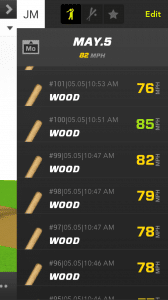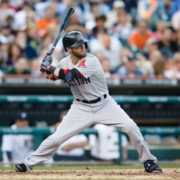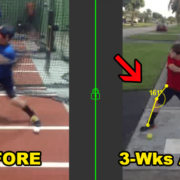Troy Tulowitzki Part-2 VIDEO: Stride Length Killing Your Bat Speed?
Troy Tulowitzki Stride Length Experiment

Photo courtesy: MLB.com
Question: Does Stride Length Kill Bat Speed?
Using the Zepp (Labs) Baseball app, I wanted to use the Scientific Method to analyze whether Troy Tulowitzki’s longer stride increases or decreases bat speed. Not just a longer stride, but I want to see the torso moving forward as well.
Background Research
Troy Tulowitzki had a wider stance in 2013. In 2014, he’s adopted more of a narrow stance and a longer stride length.
Forward Momentum may be a new concept to hitting, but not to other explosive rotational athletes. It’s also known as the Conservation of Linear Momentum and the Un-Weighting Principal. The idea is that the hitter is getting a “head start”. Other high level athletes using Forward Momentum:
- Olympic Throwers (Discus, Javelin, and Hammer)
- Olympic Shot Put
- 4 X 100 meter relay sprinters
- Circus Trapeze Artists
- Lacrosse Players
- Hockey Players
Hypothesis
I think the addition of forward momentum, or a longer stride length, will contribute to more bat speed because this gives the hitter a “head start”, making the body feel lighter while moving. This allows the body to turn harder, and ultimately increase bat speed.
Troy Tulowitzki Experiment
Equipment:
- Zepp Baseball app
,
- ATEC Tuffy Batting Tee,
- Rawlings Official NCAA Baseballs,
- Two yellow dimple baseballs,
- Galaxy S3 phone camera, and
- 33 inch, 30 ounce Pinnacle Bamboo bat.
Setup:
- Feedback markers = my bat length, plus two baseballs
- Distance from plate = end of the bat touching inside corner of plate, and knob of bat touching my mid-thigh
- NO-stride stance was width of feedback markers
- Forward movement stance was open, and feet set a little wider than shoulder width
- Tee was set a baseball or two behind the front feedback marker, and tee height was about mid-thigh
- 101 baseballs were hit using both the NO-stride and longer stride sessions
Data Collected:

Pay particular attention to the bold typeface…
Data Analysis & Conclusion

NO-stride: last 6 batted balls (Zepp Baseball app)
- 0.624 mph average bat speed increase with a longer stride.
- Apex of bell curve for NO-stride swings ranged from 77 mph to 83 mph*.
- With a longer stride, you’ll see the bell curve shifted, 81 mph to 85 mph*.
- Three more 90 mph+ swings using a longer stride, in addition to increasing my Personal Record 2 mph.
*Based on six or more batted balls repeated in specific mph (bold typeface in the chart above)
Notes

Longer Stride: last 6 batted balls (Zepp Baseball app)
- Before the experiment I did a 7 minute Dynamic Warm-up.
- I didn’t just increase my stride length, I moved my whole torso forward.
- I began the experiment with the NO-stride swings.
- I took a 20-30 minute break between the two sessions.
- During the last twenty swings of the longer stride session, I hit five-of-eight 90 mph+ balls.
From the Zepp Baseball screenshots to the right, it’s interesting to note, my bat speed kept up, even increased with forward momentum and a longer stride. In other words, I wasn’t as tired at the end of hitting over 200 baseballs.
Now that Troy Tulowitzki is using a more narrow stance and generating forward momentum with a longer stride, he’s able to increase his bat speed. This may explain the surge in opposite field home-runs in 2014.
Stay tuned for the Part-3VIDEO: Revealing the Science of Turning Faster in a couple days where we’ll be analyzing Andrew McCutchen.
- Fix Late Swings Fast: 2025 Pitch Recognition & See-Decide-Swing Training for Youth Baseball Power Hitters - October 6, 2025
- Safe Youth Weighted Bat Training: Proven Overload/Underload Drills to Increase Exit Velocity in Games Starting Tonight - September 29, 2025
- AI Coaching Course 2025: Youth Baseball & Softball Practice Plan + Off-Season & In-Season Workout Builder Fast - September 23, 2025







Leave a Reply
Want to join the discussion?Feel free to contribute!